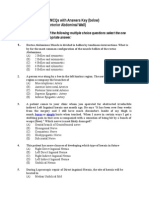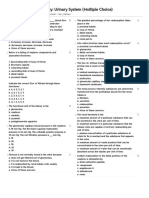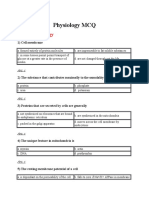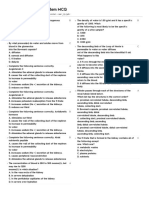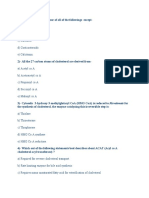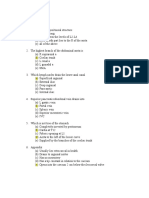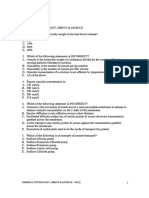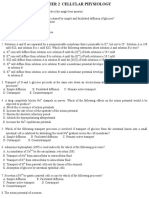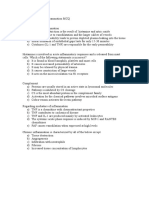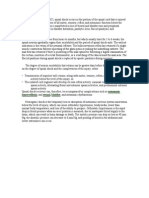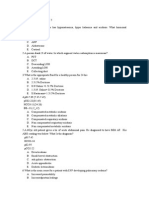100%(3)100% found this document useful (3 votes)
2K viewsMCQ Physiology
MCQ Physiology
Uploaded by
Nishanthy PirabakarThe document discusses several topics related to anatomy and physiology. It covers the normal anatomy of the heart and coronary circulation, fetal circulation, hormone production in the hypothalamus, effects of insulin and growth hormone, factors influencing aldosterone secretion, properties of parathyroid hormone, characteristics of carotid body receptors, liver blood flow, sodium concentration in different fluids, factors affecting cardiac output, properties of pulmonary vascular resistance, roles of prostaglandins, control of body temperature, control of respiration, gas content and transport in blood, effects of hypercarbia on the oxyhemoglobin dissociation curve, ECG characteristics, the cardiac cycle, properties of working myocardium, acid-base calculations, effects of high oxygen exposure, lung
Copyright:
© All Rights Reserved
Available Formats
Download as DOCX, PDF, TXT or read online from Scribd
MCQ Physiology
MCQ Physiology
Uploaded by
Nishanthy Pirabakar100%(3)100% found this document useful (3 votes)
2K views48 pagesThe document discusses several topics related to anatomy and physiology. It covers the normal anatomy of the heart and coronary circulation, fetal circulation, hormone production in the hypothalamus, effects of insulin and growth hormone, factors influencing aldosterone secretion, properties of parathyroid hormone, characteristics of carotid body receptors, liver blood flow, sodium concentration in different fluids, factors affecting cardiac output, properties of pulmonary vascular resistance, roles of prostaglandins, control of body temperature, control of respiration, gas content and transport in blood, effects of hypercarbia on the oxyhemoglobin dissociation curve, ECG characteristics, the cardiac cycle, properties of working myocardium, acid-base calculations, effects of high oxygen exposure, lung
Original Description:
physiology
Original Title
mcq physiology
Copyright
© © All Rights Reserved
Available Formats
DOCX, PDF, TXT or read online from Scribd
Share this document
Did you find this document useful?
Is this content inappropriate?
The document discusses several topics related to anatomy and physiology. It covers the normal anatomy of the heart and coronary circulation, fetal circulation, hormone production in the hypothalamus, effects of insulin and growth hormone, factors influencing aldosterone secretion, properties of parathyroid hormone, characteristics of carotid body receptors, liver blood flow, sodium concentration in different fluids, factors affecting cardiac output, properties of pulmonary vascular resistance, roles of prostaglandins, control of body temperature, control of respiration, gas content and transport in blood, effects of hypercarbia on the oxyhemoglobin dissociation curve, ECG characteristics, the cardiac cycle, properties of working myocardium, acid-base calculations, effects of high oxygen exposure, lung
Copyright:
© All Rights Reserved
Available Formats
Download as DOCX, PDF, TXT or read online from Scribd
Download as docx, pdf, or txt
100%(3)100% found this document useful (3 votes)
2K views48 pagesMCQ Physiology
MCQ Physiology
Uploaded by
Nishanthy PirabakarThe document discusses several topics related to anatomy and physiology. It covers the normal anatomy of the heart and coronary circulation, fetal circulation, hormone production in the hypothalamus, effects of insulin and growth hormone, factors influencing aldosterone secretion, properties of parathyroid hormone, characteristics of carotid body receptors, liver blood flow, sodium concentration in different fluids, factors affecting cardiac output, properties of pulmonary vascular resistance, roles of prostaglandins, control of body temperature, control of respiration, gas content and transport in blood, effects of hypercarbia on the oxyhemoglobin dissociation curve, ECG characteristics, the cardiac cycle, properties of working myocardium, acid-base calculations, effects of high oxygen exposure, lung
Copyright:
© All Rights Reserved
Available Formats
Download as DOCX, PDF, TXT or read online from Scribd
Download as docx, pdf, or txt
You are on page 1of 48
In a normal heart
a) The right coronary artery lies in the atrioventricular groove
b) The coronary sinus lies in the anterior atrioventricular
groove
c) The venae cordis minimae drain directly into the cardiac
cavities
d) There is increased forward flow through the coronary
arteries during ventricular systole
e) The blood supply to the interventricular septum arises from
the anterior descending branch of the left coronary artery.
Concerning the foetal circulation
a) It is possible for vena caval blood to each the aorta without
going through the left ventricle or left atrium
b) The pO2 in the descending aorta is less than in the ductus
arteriosus
c) The foramen ovale closes at birth because of increased left
atrial pressure
d) At birth flow in the ductus arteriosus reverses because of
decreased pulmonary resistance
e) Umbilical arterial blood has a higher PO2 than umbilical
venous blood
The following are produced in the hypothalamus
a) Prolactin
b) T.R.F
c) T.S.H
d) Vasopressin
e) A.C.T.H
Insulin and growth hormone have directly opposing effects on
a) Fat catabolism
b) Glucose utilisation
c) Fat anabolism
d) Protein anabolism
e) Glycogen production
The following influence aldosterone secretion
a) Surgical stress
b) Total sodium intake
c) Renal ischaemia
d) Angiotensin
e) Plasma potassium concentration
Parathormone
a) Increases plasma calcium concentration
b) Increases bone resorption of calcium
c) Increases urinary phosphate loss
d) Is a polypeptide
e) Causes phosphaturia
Carotid body receptors
a) Have a higher blood flow gm for gm than the brain
b) Have baroreceptors activity
c) Respond to changes in oxygen content of the blood
d) Respond to changes in pH
e) Are not affected by carotid endarterectomy
Concerning liver blood flow
a) Portal venous pressure is less than 20 mmHg.
b) 50% is from the hepatic artery
c) Total flow is 1.5 1/min
d) The liver derives most of its oxygen needs from the portal
supply
e) The oxygen saturation of portal blood is 95%
Sodium concentration is less than 50mmol in
a) Oedema fluid
b) Interstitial fluid
c) Interstitial fluid
d) A 24 Hr urine sample
e) Cerebrospinal fluid
Cardiac output is increased during:-
a) Stimulation of sympathetic cardiac nerves
b) Tension pneumothorax
c) Acclimatization to high altitude
d) Hypovolaemic shock
e) Stimulation of the sinus nerve
Pulmonary vascular resistance:
a) Is increased in hypoxia
b) Is decreased by a low pH
c) Can be measured using a flow-directed balloon catheter
d) Is increased by isoprenaline
e) Is decreased by 5-HT
One or more prostaglandins:
a) Are peptides found in prostatic secretions
b) Dilate the bronchi
c) Stimulate uterine contractions
d) Raise the intracranial pressure
e) Affect platelet function
In the control of body temperature:
a) Shivering is a spinal reflex
b) Energy from brown fat is released via beta adrenergic
receptors
c) Brain amines play and important role
d) PGEI may cause pyrexia
e) Control is independent of higher centres
In the control of respiration:
a) Hypoxic drive originates in the peripheral chemoreceptors
b) There is no significant hypoxic drive in a normal subject
breathing air at sea level.
c) The response of CO2 is linear over the normal range
d) The increased drive in exercise is due to incomplete
oxygen equilibration in the pulmonary capillaries
e) The gasping respiration of shock is a baroreceptor reflex
Gas content of blood:
a) The normal venous PO2 is approximately 5.2 kPa (40
mmHg)
b) The normal venous oxygen saturation is 75%
c) At sea level and breathing air, 0.6 ml oxygen are dissolved
in 100 ml blood containing 15 gm haemoglobin/d1
d) Nitrogen is only carried in arterial blood in the dissolved
form
e) At a PO2 of 5.2 kPa (40 mmHg) and at sea level, 47 ml
CO2 are combined with haemoglobin at a concentration of
15 gm/dl
The effect of Hypercarbia upon the oxyhaemoglobin dissociation
curve is :
a) To shift the curve to the left
b) To reduce the affinity fo haemoglobin for oxygen
c) Also temperature dependent
d) Masked by decreases in 2,3-DPG
e) Enhanced in anaemia
Regarding the ECG
a) The t wave represents ventricular depolarisation
b) The standard ECG is recorded at 50mm/sec.
c) Q-T interval is inversely related to heart rate.
d) S-T elevation occurs in pericarditis and is convex upward.
e) Information regarding muscle mass may be obtained
In the cardiac cycle
a) Atrial contraction is more important at slow, than at fast
heart rates.
c) The first heart sound is caused by an abrupt rise in
intraventricular pressure and closure of the A-V valves.
d) The fourth heart sound occurs on atrial contraction with
flow through the A-V valves.
e) PCWP normally equates with LAP.
f) The apex beat lies in the 5
th
ICS in the MCL
In the working myocardium
a) Resting membrane potential is 60v.
b) There is an increase in Na permeability during phase 0
c) Ca2+ enters the cell during phase 2.
d) ATP is bound and split by myosin ATPase.
e) No oxygen debt is incurred.
The following are correct?
a) (H+) =40 nmoml/litre if bicarbonate = 18 and PCO2= 40
mm---
b) pH=log(H+)
c) The pK of bicarbonate is 5.1
d) pH=pK +log (HC03-)
H
2
C03
e) Ph is directly proportional to the concentration of hydrogen
ions
With acute exposure to Fi02 of 10% you would expect
a) Respiratory alkalosis
b) An increase in cardiac output
c) Alkaline urine
d) Increased arterial PCO2
e) Pulmonary vasoconstriction
Concerning compliance
a) Lung compliance is les than total compliance
b) Dynamic compliance is less in a paralysed patient
c) In IPPV tidal volume depends only on compliance
d) Compliance is directly proportional to V/Q ratio
e) Compliance in a 5 year old is double than that of a 20 year
old.
The following can be determined from the volume pressure curve
a) Work of breathing
b) FRC
c) Compliance
d) Static Compliance
e) Dynamic Compliance
Breathing in the lateral position
a) Ventilation is greater in the upper lung
b) PO2 is greater in the lower lung
c) V/Q ratio in the lower lung is increased
d) Perfusion is greater in the upper lobe.
e) V/Q is about 1 near right pulmonary artery
Closing volume
a) Is 10% of a fit young persons vital capacity
b) Varies with extremes of age
c) Increases with supine position
d) Increases with obesity
e) By law is more than closing capacity
The coronary circulation
a) 90% of venous blood passes through the coronary sinus
into the RA
b) Left coronary flow is greatest mid systole
c) Auto-regulation occurs between the mean pressure of 40
and 220 mmHg.
d) ADP is largely responsible for auto-regulation
e) Isoflurane is the least potent of the inhalation agents in
reducing myocardial contractility.
f) Myocardial oxygenation increases via increasing oxygen
extraction.
With myocardial contraction
a) Energy of contraction is inversely proportional to muscle
fibre length.
c) Increased diastolic filling increases stroke volume
d) VEDP is used as a measure of EDV
e) LV performance curves plot LVSW v LEVDP
f) An LVEDP of 12 cmH20 could be normal
Regarding Cardiac Output.
a) 10% supplies the coronary circulation at rest
b) CO=BP*PVR
c) Stroke volume is more important than HR in increasing
CO in a young healthy adult.
d) Using a thermistor tipped PAFC, CO is equivalent to the
area under the cooling curve.
e) Inotropes and vasodilators may increase CO.
The neuromuscular junction.
a) The pre-post junctional gap is 100-200 A.
b) Ach is released a quanta, proportional to the third power of
the calcium concentration.
c) Pre-junctional receptors control Ach synthesis
d) MEPPs are propagated
e) Aminoglycosides are channel blockers.
Beta receptor stimulation of he heart
a) Is predominantly beta 2.
b) Increases myocardial contractility
c) Increases refractory period
d) Increases intracellular Ca2+
e) Increases A-V conduction velocity
Nervous regulation of the heart
a) Sympathetic nerve arise from T2 and T3
b) Parasympathetic stimulation leads to a fall in CO
c) Baroreceptor stimulation increases sympathetic tome
d) Heart rate increase by 20/min for each deg C rise in core
temp.
e) Sympathetic stimulation increases the slope of end systolic
pressure volume relationship
The oxy-haemoglobin dissociation curve.
a)Is left shifted by a fall in pH
b) Position is defined by the P50 (normally 40mmHg)
c) Is produced from the allosteric interaction of molecular
oxygen on he Hb molecule
d) Is right shifted by an increase in temperature
e) Is influenced by the Rapoport-Luebering shunt
The tension of 0
2
/CO
2
in blood may be determined by
a) Haldane method
b) Van-Slyke method
c) Polarography
d) Gas chromatography
e) Tonometry
Oxygen
a) 1G combines with 23ml 02
b) 1 molecule so Hb combines with four fo molecular 02
c) is responsible for the Paul-Bert effect
d) May be used in the treatment of pneumatosis coli
e) Is a product fo photosynthesis
Pulmonary blood volume
a) Is normally 20% of TBV
b) 250ml. Blood is within pulmonary capillaries in an adult
c) Acts as a reservoir
d) Decreases in inspiration
e) Increases with mitral stenosis
Parathyroid hormone
a) Raises plasma ionised calcium concentration
b) Increases osteoclast activity
c) Increases the reabsorption of phosphate
d) Decreases production of 1, 25 DiOH CC.
e) Increases Alkaline Phosphatase
Creative Kinase (CPK)
a) Is found in heart muscle, kidney and skeletal muscle.
b) Increases in hypothyroidism
c) Reduces in alcoholism
d) Increases with parturition
e) May increase post CVA.
Iron
a) Total body iron is 150mmol (8g).
b) 70% is in the RBC.
c) Is essential for oxidative phosphorylation
d) Is stored in he reticuloendothelial system
e) Parenteral therapy may easily lead to iron overload.
Compensatory mechanisms for a primary acidosis include:-
a) Hyperventilation
b) Increased urine pH
c) Elevated CSF bicarbonate
d) Decreased carbonic anhydrase activity within the renal
tubular cells
e) Bicarbonate excretion to control urine pH.
Nerve conduction
a) At the height of the action potential the membrane
potential approaches the equilibrium potential balancing the
ions on the tow sides of the membrane
b) The duration of the refractory period limits transmission
frequency
c) Is fastest in myelinated fibres
d) Saltatory conduction involves sodium and chloride
permeability alone.
e) Speed is always directly proportional to the thickness of the
nerve fibres
Potassium balance:
a) Is acutely regulated by changes in concentration across cell
membranes
b) Plasma levels are acutely elevated by an alpha adrenergic
affect
c) Hyperkalaemia decreases glucagon secretion
d) Intracellular alkalosis decreases serum potassium
e) 90% of the total body potassium is intracellular
The following statements are true of the oxyhaemoglobin
dissociation curve:
a) The p50 is approximately 3.6 kPa (27 mmHg)
b) The curve moves to the right if there is Hypercarbia
c) The curve moves to the left if there is acidaemia
d) The p50 is decreased by a raised PaCO2
e) The steepest part of the curve is below the normal venous
point.
The following changes occur in acclimatization at altitude;
a) The kidneys excrete an acid urine
b) The red bone marrow is suppressed
c) Cardiac output increases
d) The haemoglobin concentration rises
e) The shape of chest wall changes to favour pump handle
movement
The following are true for jugular venous pressure tracings:-
a) The a wave is due to atrial systole
b) The summit of the v wave marks the beginning
of ventricular systole
c) The a-v interval is a guide to the conduction time of the
bundle of His
d) The c wave is due to bulging of the artio-ventricular
valves into the atrium
e) The v wave is due to filling of the atrium with the atrio-
ventricular valves closed.
The following cause vasodilation of the peripheral arterial blood
vessels:
a) Thromboxane A2
b) Endothelin
c) Adenosine diphosphae (ADP)
d) Nitric oxide (NO)
e) Prostacylin
In decompression sickness:
a) Bubbles of carbon dioxide form in the tissues
b) Joint pain is typical feature
c) Symptoms typically begin 48 h after returning to
atmospheric pressure
d) The condition is commoner in smokers
e) Recompression should be rapid.
The following are physiological effects of hyperventilation.
a) Increased pulmonary artery pressure
b) Peripheral arteriolar vasodilation
c) A shift to the left in the oxygen dissociation curve
d) Fall in plasma potassium concentration
e) Alakalosis
Saltatory conduction:-
a) Occurs only in myelinated nerve fibres
b) Is conduction of an action potential between schwann cell
nuclei
c) Is slowed as temperature falls
d) Is faster in nerve fibres of larger diameter
e) Occasionally occurs in un-myelinated nerve fibres
The carotid sinus:
a) Is located at the origin of the internal carotid artery
b) Contains receptors that are sensitive to blood pH
c) Is innervated by the glossopharyngeal nerve
d) Causes peripheral vasodilation when stimulated
e) Becomes hypersensitive, particularly in young women.
Adult haemoglobin:-
a) Contains four molecules of globin
b) Combines with carbon dioxide
c) Combines with carbon monoxide at the same site on the
haemoglobin molecule as oxygen
d) Carries molecular rather than ionic oxygen
e) Production is increased by direct action of hypoxia on the
bone marrow
The QRS complex on he electrocardiogram:-
a) Is caused by ventricular myocardial repolarisation
b) Will normally contain a Q-wave up to half the height of the
R-wave
c) Corresponds with the phase of isovolumetric contraction
d) Is shortened in tricyclic poisoning
e) May be used to assess rotation of the heart along its
longitudinal axis
Growth hormone and insulin has opposite effect in:-
a) Carbohydrate uptake by muscle
b) Anabolism of fat
c) Catabolism of fat
d) Protein synthesis
e) Amino acid uptake
The following hormones are produced by the hypothalamus:
a) Corticotrophin releasing factor
b) Prolactin
c) ADH
d) TSH
e) Growth hormone
Reduced FRC
a) In the obese
b) Assuming an upright posture
c) Following anaesthesia
d) Is more pronounced after upper abdominal than peripheral
surgery
e) Increased gaseous induction time
A decrease in arterial oxygen tension would occur with :-
a) Old age
b) Breathing 1% carbon monoxide
c) Anaemia
d) Pregnancy
e) High attitude
A marked increase in ventilation would be caused by:-
a) Breathing air containing 0.3% carbon monoxide
b) Deceasing CSF pH
c) A rise in the blood pH to 7.45
d) With an increase of arterial carbon dioxide above 10 Kpa
e) Administration of Doxapram
In the explosive phase of a cough
a) Intrapleural pressure may rise to 50 mmHg
b) There is a decrease in cerebral perfusion pressure
c) There is a narrowing of the airways
d) There is contraction of the diaphragm
e) There is closure of glottis
Intrapleural pressure
a) Can be measured with an oesophageal balloon
b) Is related to diffusion of O
2
into the Intrapleural space
c) Becomes increasingly negative with increasing lung
volumes
d) Equals atmospheric pressure at FRC
e) Is more negative at the apices because of the weight of the
lungs
Calcitonin
a) Is produced in parathyroid glands
b) Is simulated by calcitonin releasing factors
c) Inhibits bone resorption
d) Decreases plasma calcium
e) Influences metabolic rate
With 24 hour starvation there is
a) An increase in Lipolysis
b) Respiratory quotient increase
c) An increase in Glucocorticoids
d) Hypoglycemia
e) Dehydration
The following are true:-
a) Fats are predominantly absorbed in the ileum
b) Vit K is absorbed in the stomach
c) Bile salts are absorbed in the duodenum
d) Iron is absorbed in the terminal ileum
e) Water is predominantly absorbed in the rectum
Human erythrocytes:-
a) Contain more potassium ions than calcium ions
b) Are formed from megakaryocytes in bone marrow
c) Contain carbonic anhydrase
d) Have a life of between 110 and 130 days
e) Have average diameter of 10-12 microns (micrometers)
The following substances are necessary for normal erythropoiesis:-
a) Ascorbic acid
b) Folic acid
c) Vitamin E
d) Iron
e) B
12
Increase in 2.3 diphosphoglyceric acid (2,3, D.P.G.) concentration
in red blood cell influences:-
a) The oxygen consumption of the cells
b) The life of stored red blood cells
c) The oxyhaerroglobin blood dissociation
d) The rate of carbonic acid formation by red cells
e) The pH of the plasma
In a normal adult the differential white cell count includes:-
a) Neutrophis 65 to 70 percent
b) Lymphocytes 20 to 25 percent
c) Monocytes 5 to 8 percent
d) Eosinophis 0 to 4 percent
e) Basophil 0 to 1 percent
Compared with intracellular fluid, the extracellular fluid contains a
greater concentration of :-
a) Sodium ions
b) Magnesium ions
c) Protein
d) Hydrogen ions
e) Bicarbonate ions
Antidiuresis for 12 or more hours leads to
a) Retention of sodium
b) Decrease in plasma corisol
c) Increased renal excretion of nitrogen
d) Increased renal excretion of potassium
e) Decrease in plasma osmolality
Straining during defecation cause an immediate:-
a) Rise in the aortic blood pressure
b) Rise in the central venous pressure
c) Increase in arterial PCO
d) Fall in the intracranial pressure
e) Increase in the intraocular pressure
The following secretions of the stomach are essential
a) HCI
b) Persin
c) Renin
d) Intrinsic factor
e) Gastrin
The effects of an increase in efferent vagal activity include:-
a) Slowing of the heart rate
b) Increased contractility of atria
c) Decreased chronotropism
d) Slowing of conduction between ventricles
e) Bronchospasm
Hypoxaemia stimulates respiration by an action on:-
a) The carotid sinus
b) Central pH
c) Central respiratory neurones
d) The carotd and aortic bodies
e) Central chemoreceptors in the hypothalamus
The alveolar carbon dioxide tension:
a) Is normally 36-44 mm Hg
b) Is normally 3-6 mm Hg below the arterial tension
c) Influences the alveolar oxygen tension during air breathing
d) Increases during pregnancy
e) Roughly doubles when alveolar ventilation is halved.
Surfactant:-
a) Increase surface tension in the alveoli
b) Can be detected in normal amniotic fluid at term
c) Prevents collapse of alveoli at low lung volume
d) May be deficient in premature infants
e) Maintains the normal permeability of the alveolo-capillary
membrane
A healthy person exposed to an acute reduction in the partial
pressure of oxygen to 50 mm Hg in the inspired air will:-
a) Develop respiratory alkalosis
b) Secrete more acid urine
c) Have increased pulmonary vasoconstriction
d) Have an increased cardiac output
e) Have a reduction in the oxygen carrying capacity of his
blood.
Reabsorption of glucose in the kidneys:-
a) Occurs in the distal convoluted tubule
b) Is directly controlled by the plasma glucose level.
c) Is directly controlled by insulin secretion
d) Is inhibited by phloridzin
e) Does not require adenosine triphosphate
The mass of gas dissolved in a liquid at constant ambient
temperature depends upon the:-
a) Temperature of the liquid
b) Partial pressure of the gas
c) Diffusion coefficient
d) Solubility of the gas in the liquid
e) Critical temperature of the gas.
The oxygen dissociation curve of blood:-
a) May be constructed by plotting the oxygen content against
the oxygen tension
b) Is shifted to the left in the foetus
c) Is shifted to the left with raising the hydrogen ion
concentration
d) Is shifted to the right by raising the temperature
e) Is hyperbolic in shape
Peripheral arterial resistance is raised by:-
a) Injection of noradrenaline
b) Increased stroke output
c) Baroreceptor stimulation
d) Hypovolemia
e) Hyperactivity of the juxta-glomerular apparatus
During severe exercise the :-
a) Oxygen saturation of mixed venous blood is 70 percent
b) Heart rate may rise to over 150/min
c) Pulmonary vascular resistance falls
d) Cardiac output may reach 20-30 litres/min
e) Venous pressure rises
Plasma colloid osmotic pressure:-
a) Depends largely on plasma albumin concentration
b) Makes a large contribution to plasma osmolality
c) Is lower than the colloid osmotic pressure of lymph
d) Is affected by the haemoglobin concentration in the red
cells
e) Can be raised by intravenous Mannitol
The normal metabolic response to an operation includes:-
a) Antidiuresis for 12 to 24 hours
b) Retention of sodium
c) Decrease in plasma cortisol
d) Increased renal excretion of nitrogen
e) Increased renal excretion of potassium
Pulmonary vascular resistance may be increased by:-
a) Hypoxia
b) Acidawmia
c) Exercise
d) The valsalva manoeuvre
e) Serotonin (5-hydroytryptamine)
Cardiac output:-
a) Is the volume of blood pumped out by either
ventricle in one minute
b) Is the product of the heart rate and stroke volume
c) Is under nervous control only
d) May be measured by the Fick principle
e) Falls on assuming the erect posture from the
horizontal
The resting membrane potential of a nerve cell:-
a) Is normally about 70 mv internally
b) Is related to the relative concentrations of chloride
inside and outside
c) Is little altered by changing the external Na
concentration
d) Requires the presence of a sodium pump
e) Is highly dependent on the external concentration of
potassium
The following are true:-
a) Fructose is a disaccharide of glucose and galactose
b) Following a meal the blood pyruvate concentration
increases.
c) Leucine is a branched chain amino acid.
d) Insulin is required for the production of free fatty acids
from stored triglycerides.
e) Uncoupling of oxidative metabolism occurs in brown fat.
The complement system plays an important role in the following:-
a) Mantoux reaction
b) Virus inactivation.
c) Phagocytosis by neutrophils.
d) IgE binding to mast cells.
e) Neutrophil chemotaxis
Calcitonin is:-
a) A peptide hormone
b) Secreted by the parathyroid glands
c) Inhibits osteoblast activity
d) Is secreted following pentagastrin infusion
e) Is functionally antagonised in its action on bone by
Parathormone.
Ferritin
a) Is involved in the transfer of iron across the gut wall.
b) Is involved in he tissue storage of iron
c) Is involved in the transfer of iron to the liver
d) Is involved in the transfer of iron to muscles
e) Is destroyed immediately after use.
The following increase on rising from lying down :-
a) Cardiac output
b) Renin secretion
c) Vital capacity
d) Dead space
e) Central venous pressure
Unilateral section of the cervical sympathetic chain causes:-
a) Nasal mucosal hypertrophy on the affected side
b) Enopthalmos on the affected side
c) Mydriasis on the affected side
d) Excessive lacrimation on the affected side
e) Failure of accommodation
Acetylcholine is the neurotransmitter:-
a) At sympathetic preganglionic terminals in the adrenal
medulla.
b) At parasympathetic postganglionic terminals in the parotid
gland
c) At sympathetic postganglionic terminals in sweat glands
d) At pupillary sympathetic dilator fibres
e) At sympathetic ganglia
The following muscles are important in forced expiration:-
a) External intercostals
b) Internal intercostals
c) Diaphragm
d) Serratus anterior
e) Abdominal muscles
The hepatic blood flow:-
a) Is 1.5 L/min in normal adults
b) 40% comes from the hepatic portal vein
c) The hepatic portal venous pressure is 80 mmHg
d) 70% of the hepatic oxygen supply come from the hepatic
artery
e) Is increased by GTN
Myosin
a) Is found only in muscle cells
b) Is composed of tropomyosin and troponin
c) Is linked to actin by cross bridges
d) Is surrounded by sarcoplasmic reticulum
e) Contains an ATPase
In the mechanism of normal clotting
a) Widespread tissue damage produces a substance that
interferes with the process
b) Vitamin C is necessary
c) The normal whole blood clothing time is less than tow
minutes
d) Clot retraction is mediated by platelets
e) Factor VI is important
The QRS complex of a normal ECG
a) Is less than 0.2 seconds
b) Has the same amplitude no matter from where it is
recorded on the chest wall
c) Is exactly synchronous with ventricular contraction
d) May vary in amplitude with respiration
e) Varies in duration with changes in heart rate.
The carotid bodies:-
a) Have a blood flow in mls/kg/min less than that of the brain
b) Are more sensitive to p02 than oxygen content
c) Have a high resting oxygen consumption
d) The afferent connections are via the vagus nerve
e) Contain baroceptors
Sodium ions normally have a concentration of more than 50
mmol/L in
a) Urine
b) Oedema fluid
c) Intracellular fluid
d) Extracellular fluid
e) CSF
Pregnancy is associated with a rise in
a) Total red cell mass
b) Protein bound iodine
c) Cardiac output
d) Total body water
e) Circulating fibrinogen
The hypothalamus contains cells which produce
a) Growth hormone
b) Vasopressin
c) Proplactin
d) Oxytocin
e) TSH
In normal arterial blood
a) Hydrogen ion concentration equals 40 nmols/L
b) PH equals the log of the hydrogen ion concentration
c) The pK of the bicarbonate system is 6.1
d) PH = pK + log (10) (HCO3-) / (H2033)
e) The solubility coefficient for carbon dioxide is 0.03 ml /
100 ml/ mm Hg
The pulmonary circulation
a) Has a mean pressure one-third that of the systemic
circulation
b) Contains 50% of the blood volume
c) The PA occlusion pressure is equal ot the La pressure
d) Responds to hypoxia by a decrease in its resistance
e) The VQ ratio at the apex in the standing position is zero
Cerebrospinal fluid
a) Has the same PO2 as arterial blood
b) Protein content is the same as plasma
c) Has the same pH as plasma
d) Has a higher glucose content than plasma
e) Chloride level is higher than plasma
Acute painful stimulation of the left foot causes
a) Activation of the flexor muscles of the left leg
b) Extension of the contra-lateral limb
c) Impulses bypass the thalamus
d) Impulses pass up the spinal cord in the contra-lateral
spinothalamic tract
On changing posture from supine to sitting there will be
a) A reduction in the blood volume in the lung
b) Apical V/Q ratio in the lung will approach infinity
c) An increase in heart rate
d) An increase in functional residual capacity
e) A decrease in alveolar PCO
2
Total hepatectomy will lead to:-
a) Hypoglycaemia
b) Decreased amino acid level
c) Decreased fibrinogen
d) Increased urea
e) Decreased ratio of albumin to globulin
Considering the action potential of a ventricular muscle cell
a) It has a similar duration as the refractory period
b) Shows phase 4 depolarisation
c) The plateau is due to influx of calcium ions
d) The refractory period and ventricular muscle contraction
are of similar duration
A pregnant woman will have increased
a) Blood flow to her hands
b) Total body water
c) Red cell mass
d) Pulmonary Vascular Resistance
e) Extravascular water
The anterior pituitary
a) Produces vasopressin
b) Has a separate portal blood supply to the posterior lobe
c) Undergoes separate development from the posterior
pituitary
d) Has a direct neural connection with the pineal gland
e) Contains chromophobe cells
Cardiac output is reduced in
a) Hypothyroidism
b) Response to carotid sinus stimulation
c) Peripheral vasodilatation
d) After a heavy meal
Anaemia is clinically evident when
a) there is over 5 g/dl of carbaminohaemoglobin
b) Hb is less than 10 g/dl
c) SaO2 is 90%
d) There is 10g/100ml carboxyhaemoglobin
e) PaO2 = 70 mmHg.
Myocardial contractility is increased by increasing
a) Initial muscle fibre length
b) Circulating catecholamines
c) Extracellular potassium concentration
d) Extracellular ionised calcium concentration
In forced expiration the following muscles are active
a) Diaphragm
b) External oblique
c) Internal oblique
d) Scalenus anterior
e) Rectus abdominis
Venous return to the heart is assisted by
a) Descent of the diaphragm
b) Increased intrathoracic pressure
c) Unidirectional valves in the inferior vena cava
Absorption of:-
a) Water in the gut is active
b) Iron occurs in the duodenum
c) Fat occurs in the jejunum
d) Bile salts occurs in the ileum
e) Sodium chloride in the proximal renal tubule is controlled
by aldosterone
An increase in erythrocyte 2-3 DPG
a) Occurs in stored blood
b) Occurs in chronic anaemia
c) Shifts the O2 dissociation curve in the same direction as a
decrease in pH
d) Shifts the O2 dissociation curve in the same direction as
hypothermia
e) Increases erythrocyte oxygen consumption.
A driver breathing air at 30 m below sea level
a) Is subjected to a pressure of 4 atmospheres
b) Would be unconscious as a result of nitrogen narcosis
while at this depth
c) The work of breathing is increased
d) The O2 content of arterial blood is 2-3 times normal
e) Runs the risk of gas bubbles forming in his central nervous
system at this depth.
An increase in resting minute volume occurs
a) When breathing 3% CO2
b) If PAO2 falls to 75 mmHg
c) In a chronic anaemia with Hb of 5 g/dl
d) In high altitude
e) In metabolic acidosis
Surfactant
a) Is a carbohydrate
b) Diffuses out from pulmonary capillary blood
c) Reduces pulmonary tension
d) Production is increased in pre-term neonates
e) Exogenous surfactant is derived from animals
In pregnancy
a) There is arise in total peripheral resistance
b) Packed cell volume increases
c) There is a fall in plasma T3
d) There is a fall in arterial PCI2
e) Red cell mass increases
A normal adult 2 days after uncomplicated major abdominal
surgery may have the following 24 hr urine results
a) Volume 500 ml.
b) Sodium 20 mmol/day
c) Potassium 10 mmol/day
d) Nitrogen 15 g/day
e) Urea 20 mg/day
The following are needed for erythropoiesis
a) Vitamin B12
b) Angiotensin
c) Calcitonin
d) Pyridoxine
e) Folic acid
Transferring
a) Is involved in the direct transfer of iron from the
gut lumen to mucosal cells
b) Involved in transfer of iron from mucosal cells to muscle
c) Is involved in transfer of iron to and from bone marrow
d) Is destroyed once transport has been completed
e) Is involved in the transport of iron from the gut to iron
stores
Anatomical dead space
a) Is approximately 1 ml/kg
b) Increases on rising from supine to erect position
c) Increases with a rise in circulating adrenaline
d) Is normally about one third of tidal volume
e) Is increased by pneumonectomy
A normal 20kg child compared with an adult
a) Has a higher total peripheral resistance
b) Has a higher basal metabolic rate per m2 body surface area
c) Has greater lung compliance
d) Has a blood volume closer to ------------ than 3 1
e) Has a mean systemic blood pressure of 65 mmHg
The effects of intrapulmonary shunt may be distinguished from
those of V/Q mismatch by
a) Carbon monoxide transfer
b) The helium steady state test
c) Calculation of the arteriovenous PO
2
difference
d) Inspiration of 100% oxygen
e) Calculation of the A-a PCO
2
difference
Gastric emptying time is increased by
a) Acid in the duodenum
b) Fat in the oesophagus
c) Increased blood secretin concentration
d) Increased size of meal
e) Sympathetic stimulation
Histamine
a) Is responsible for some features of the Lewis triple
response
b) Administered Intravascularly causes an immediate rise in
blood pressure
c) Causes the secretion of an acid mucous in the stomach
d) Is a pre-capillary vasodilator
e) Is responsible for Anaphylactoid reactions
Uncompensated respiratory acidosis causes
a) Increased plasma bicarbonate concentration
b) Increased urinary bicarbonate excretion
c) Increased urinary potassium excretion
d) Raised intracranial pressure
e) Increased pH
Parathormone
a) Increases plasma calcium concentration
b) Increases calcium resorption from bone
c) Increases urinary phosphate excretion
d) Is a polypeptide
e) Secretion is regulated by plasma calcium concentration
In the foetal circulation
a) Partial pressure of O2 is greater in the ductus venosus than
in the ductus arteriosus
b) Blood can get from the vena cava ot the aorta without
going through left atrium or left ventricle
c) PaO2 in aortic arch is greater than PaO2 in descending
aorta
d) Foramen ovale closure is the result of reversal of atrial
pressures difference
e) After birth, flow through the ductus arteriosus is stopped or
reversed as a result of the increase in pulmonary artery
pressure
Venous return is decreased
a) After a heavy meal
b) During exercise
c) In anaemia
d) By an increase in cardiac output.
e) In congestive cardiac failure
The following are precursors of adrenaline:-
a) Noradrenaline
b) Tyrosine
c) Isoprenaline
d) Phenylalanine
e) Dopamine
An increase in plasma renin levels occurs with increases in
a) Angiotensin levels
b) Extracellular sodium
c) Extracellular potassium
d) Renal perfusion pressure
e) Intravascular volume
In body fluids:-
a) Intracellular (K
+
) is greater than Extracellular (K
+
)
b) Intracellular (HCO
3
-
) is greater than Extracellular (HCO
3
-
)
c) Intracellular (Mg
+
) is greater than Extracellular (Mg
+
)
d) Intracellular H
2
O is greater in volume than Extracellular
H
2
O
e) Intracellular (Na
+
) is greater than Extracellular (Na
+
)
A sodium concentration of over 50 mmol/l occurs in
a) Normal saline
b) Cerebrospinal fluid
c) Extracellular fluid
d) Intracellular fluid
e) Oedema fluid
Cerebrospinal fluid
a) K
+
concentration is between 2.0 and 3.5 mmol/l
b) Specific gravity is 1008
c) Protein content is 400-600 mg/l
d) Is produced by the arachnoid villi
e) Is isosmotic with plasma
Unilateral blockade of the sympathetic chain produces
a) Enophthalmus
b) Miosis
c) Conjunctival vasodilation
d) Decreased Iacreimation
e) Pupillary dilation
The following influence the absorption of an orally administered
drug
a) Pharmacological formulation
b) Dose
c) Intestinal pH
d) Presystemic (hepatic) metabolism
e) Speed of gastric emptying
Most group I antiarrhythmics
a) Slow depolarisation in cardiac conducting tissue
b) Increase action potential duration
c) Increase the threshold of cardiac conducting tissue
d) Have local anaesthetic action
e) Are useful in atrial arrhythmias
In skeletal muscle:-
a) Think filaments are myosin
b) Thin filaments are action and tropomyosin
c) Calcium binds to troponin C
d) Energy released from hydrolysis of ATP is directly related
to muscle work.
e) At the start of contraction, calcium is released from the
lateral cisterns of the sarcoplasmic reticulum
Total body water
a) Constitutes 2/3 of adult body weight
b) Can be measured by deuterium oxide
c) Increases with age
d) Is proportionally greater in woman than men
e) Is proportionately greater in children than adults
Intrapleural pressure :-
a) Is sub-atmospheric throughout normal breathing at rest
b) Becomes more sub-atmospheric during inspiration
c) Can be assessed by measurement of intragastric pressure
d) Is higher at the base than the apex when sitting
e) Rises above atmospheric pressure during a forced
expiration against resistance
Physiological dead space:-
a) Can be greater than anatomical dead space
b) Remains constant when tidal volume changes
c) Accounts for the difference in composition between
alveolar and expired gas
d) Is increased during general anaesthesia
e) Can be calculated from tidal volume and the CO2
concentrations fo expired and alveolar gas
Pulmonary surfactant:-
a) Increases surface tension
b) Prevents segmental collapse
c) Increases alveolar ciliary motion
d) Aids alveolo-capillary diffusion
e) Is increased in respiratory distress syndrome of the
newborn
Oxygen percentage saturation of arterial blood depends on:-
a) Alveolar oxygen tension
b) Haemoglobin content of blood
c) Cardiac output
d) Arterial CO
2
tension
e) Arterial H concentration
Carbon dioxide:-
a) Causes dilation of cerebral vessels
b) Has a normal tension in arterial blood of 36-44 mmHg
c) Affects the excitability of neurones in he reticular
activating system
d) Has a tension in mixed venous blood 6 mmHg higher than
in arterial blood
e) Displaces oxygen from haemoglobin
The carotid body chemoreceptors:-
a) Are stimulated by a fall of arterial 0
2
tension
b) Are inhibited by a fall of arterial pH
c) Reflexly produce peripheral vasoconstriction
d) Are subject to increased stimulation in the anaemic patient
at rest
e) Have a blood flow of over 1 litre/ 100 g/ minute
Over-ventilation causes :-
a) Raised arterial CO
2
tension
b) Lowered plasma ionised calcium concentration
c) Cerebral hypoxia
d) Decreased arterial 0
2
tension
e) Increased arterial pH.
In the normal pulmonary vascular bed:-
a) The mean pulmonary arterial pressure is half the mean
aortic pressure
b) The pulmonary vascular resistance is lower than the
systemic vascular resistar
c) There is always 50% of the blood volume
d) The wedge pressure equals capillary pressure
e) Hypoxia causes dilatation of vessels.
Plasma from group A blood will agglutinate:-
a) Only group AB
b) Only group B
c) Group B blood and group AB blood
d) Group AB blood, group B blood and group O blood
e) Group B blood and group O blood
Antidiuretic Hormone:-
a) Is synthesised in he hypothalamus
b) Increases the permeability of th proximal tubules to water
c) May be secreted in excess during stress
d) In large doses can cause smooth muscle contraction
e) Secretion is controlled by ICF (intraoellular fluid)
Cerebral blood flow:-
a) Decreases by half when PaCO
2
falls to 20 mmHg
b) Is auto-regulated between mean arterial pressure 40-200
mmHg
c) Increases when PaCO
2
is less than 50 mmHg
d) Is controlled by sympathetic nervous system
e) Is increased by a rise in hydrogen ions in the brain.
The following enzymes are involved in glycogenesis:-
a) Glucokinase
b) Phosphoglucanutase
c) Glucose-6-phosphatse
d) Glycogen synthetese
e) Debranching enzyme
Extracellular fluid:-
a) Contains sodium and chloride as the predominant ions
b) Has the same osmotic concentration a sea-water
c) Accounts for about 40% of the body weight in adults
d) Has a lower proportion of body weight in infancy than in
old age.
e) Predominant buffer is protens
The velocity of nerve impulse propagation:-
a) Increases with pressure on the nerve
b) Increases with metabolic acidosis
c) Increases with myelination of the nerve
d) Increases proportionally with the diameter fo the nerve
e) Is greater in motor than in sensory nerve
Concerning calcium balance:-
a) Vitamin D increase calcium reabsorption from the gut
b) Parathormone increases serum calcium
c) Calcitonin reduces serum calcium
d) Calcium absorption is reduced by glucocorticoids
e) Calcium is mainly excreted in the urine
Oxygen concentration in a gas mixture may be measured by:-
a) A severinghaus electrode
b) A Clarke electrode
c) Polarography
d) The paramagnetic effect
e) Infra-red analysis
Closing volume:-
a) Is low at birth
b) Increases from adolescence to old
c) Always include FRC
d) Is always higher when supine than when upright
e) Is measured by slow expiration after a full inspiration of a
marker gas.
Concerning acid-base balance:-
a) The buffering power of plasma is greater in vitro than in
vivo
b) Buffering is greater if haemoglobin concentration is higher
c) Base excess will vary with haemoglobin concentration
d) An increase in the slope of the buffer line (i.e. steeper)
means that buffering is increased
The following concerns pain:-
a) Transmission occurs in the lateral spinothalamic tract
b) Modulated at spinal level by endorphins
c) Modified at spinal level by descending fibres from
periaqueductal grey matter in the mid-brain
d) Cerebral cortex modified the thalamic interpretation of
pain.
e) Is not associated with psychological or emotional response
to noxious stimuli.
Physiological dead space:-
a) Can be greater than anatomical dead space.
b) Remains constant when tidal volume changes
c) Accounts for the difference in composition between
alveolar and expired gas
d) Is increased during general anaesthesia
e) May be calculated from the CO
2
tensions in mixed expired
gas and arterial blood.
Cerebral blood flow is:-
a) Increased by Hypercarbia
b) Decreased by blood catecholamines
c) Decreased by the valsalva manoeuvre
d) Increased by raising the mean blood pressure from 120 to
140 mmHg.
e) Subject to regional fluctuations.
An artificially-induced reduction of body temperature of 5C is
likely to lead to :-
a) A reduction in oxygen consumption
b) An increase in potency of d-tubocurarine
c) A shift of the oxygen-haemoglobin dissociation curve to
the right.
d) A fall in the output off T3 hormone from the thyroid
e) A reduction in cerebral blood flow.
Methaemoglobinaemia:-
a) Is caused by Bupivacaine
b) May confused with oxyhaemoglobin by pulse oximeter
c) Shifts the oxygen dissociation curve to the right.
d) May be caused by Sodium Nitropruside
e) Blood normally has more carboxyhaemoglobin than
Methaemoglobin
Human albumin solution
a) Is stored at room temperature
b) Has at least 4.3 g of protein per 100 ml.
c) Is used in the treatment of DIC.
d) Has approximately 145 mmol/1 sodium
e) Is associated with a risk of hepatitis
Foetal haemoglobin:-
a) Disappears in the first month after birth
b) has alpha and beta subunits
c) protects against sickling in homozygous babies with Hbs.
d) Can be present in adults.
e) Has a lower 02 affinity than adult haemoglobin
A patient with a Hb of 10g/d and PO
2
100 mm Hg (at normal pH
PCO
2
and temperature):-
a) Will have an O
2
capacity of 13.9 mls/1000 mls blood
b) Would have the capacity increased to 30 mls/100 mls if
Hb was increased to 15 g/dl
c) Will have a saturation of approximately 96%
d) Will have little change in saturation if the PO
2
drops to 90
mm Hg
e) 0.03 ml dissolved 0
2
/100 mls blood.
The P50 value:-
a) Is normally 2.5 Kpa
b) Is the PO
2
at which 50% saturation occurs
c) When increased indicates a shift of the O
2
dissociation
curve to the ( R ) and facilitated tissue oxygenation
d) Is increased when pH increases
e) Is increased by methaemoglobinaemia
Haemoglobin:-
a) Contains an iron porphyrin compound in which iron in the
ferrous from is reversibly oxidised
b) In sickle cell anaemia it is Hb A which contains valine
instead of glutamic acid on the B chains
c) When fully saturated combines with 13.4 mls O2 per gram
d) Affinity for 02 is responsible for the sigmoid shape of the
02 dissociation curve
The following come from the anterior pituitary:-
a) Somatostatin
b) Oxytocin
c) Prolactin
d) Thyrotropin
e) Aldosterone
Which fo he following are consequences of breathing 5 M CO2 in
air?
a) There is a rise in the P002 of mixed venous blood
b) The pH of the arterial blood rises
c) There is an increase in alveolar ventilation
d) The oxygen dissociation curve of haemoglobin is shifted to
the left.
e) There is a reduction in cerebral blood flow
The following are statements about the consequences of
voluntarily increasing ventilation three fold.
a) The alveolar P02 trebles
b) The plasma proteins become more ionised
c) The plasma ionised calcium level increases
d) A fall in the plasma bicarbonate concentration of arterial
blood
e) A brief period of apnoea immediately afterwards.
The following reduce a total pulmonary compliance
a) Fibrosing alveolitis
b) Emphysema
c) Mitral stenosis of long duration
d) Ankylosing spondylitis
e) Adult respiratory distress syndrome
The following cross placenta
a) Aspirin
b) Morphine
c) Propranolol
d) Gllycery Trinitrate
e) Frusemics
The following act to block protein synthesis:-
a) Penicillin
b) Actinomycin D
c) Tetracycline
d) Chloramohenicol
e) Trimethoprim
The following are true:-
a) Cimetidine increases the effect of warfarin.
b) Erythromycin increases the effect of Warfarin
c) Sodium valproate increases the effect of Heparin
d) Rifampicin increases the effects of oestrogens
The following stimulate secretion of growth hormone in healthy
humans:-
a) Sometestatin
b) Somatomeain
c) Somatomeain 0
d) Sleep
e) Hyperglycaemia
The following reduce secretion of gastic acid and gastrin :-
a) Cimetidine
b) Propanthelene
c) Carbenoxolone
d) Sucralfate
e) Colloidal bismuth
A patient breathing air has a Pa02 of 7.5 kPa and a PaCO2 of 3.5.
These are compatible with:-
a) Pulmonary cedema
b) Obesity
c) Anklyosing spondylitis
d) Barbiturate overdose
e) Lobar pneumonia
In normal humans, renal plasma flow:-
a) Mostly distributed to the renal medulla
b) Varies significantly with systemic arterial blood pressure
c) May be calculated from para-aminohippuric acid clearance
d) Increases in the supine position
e) Has a close correlation with body weight.
Answer true or false:-
Myelinated primary afferent neurous
a) carry nociceptive impulses
b) Have cell bodies in the dorsal root ganglia
c) Have polymodal specialised sensory receptors
d) Have central terminals in Rexed lamina IV
e) Bifurcate on entry into the dorsal horn, passing rostrad and
caudal.
Substance P:-
Is found in the central and peripheral terminals of the primary
afferent neuron
a) Is found in the dorsal root ganglia type B cells
b) Is not involved in pain transmission
c) Depletion by capsaicin makes animals insensitive to pain
d) Is released into the CSF in response to pain.
Transmitters involved in inhibiting nociceptive information include
the following:-
a) Endogenous 2opiate peptides
b) Inhibiting amino acids (GABA and Glycine)
c) Noradrenaline
d) Serotonin (5-Ht)
e) Dynorphin
The A-receptor:-
a) Is activated by the agonist fentanyl.
b) Is activated by ht agonist antagonist buprenorphine
c) Mediates analgesia but not respiratory depression
d) Is found in high concentrations in the prei-aqeducted grey
matter
The following are involved in transmission at autonomic ganglia:-
a) Noradrenaline
b) Acetyl Choline
c) G.A.B.A
d) Prostaglandins
e) Adrenaline
In the normal subject the cerebral blood flow will be increased by:-
a) An increase in the arterial pCO2 to about 60 mmHg
b) A head-down posture
c) An increase in systolic blood pressure from 110 mmHg to
130 mmHg
d) Hyperventilation
e) A rise in the arterial pO2
The blood oxygen dissociation curve is shifted to the left by:-
a) Low temperature
b) Low haemoglobin levels
c) Hypoxia
d) Acidosis
e) Alkalosis
In the normal heart:-
a) The resting potential on the outside of a muscle cell is +80
to +90 mV
b) The time between spontaneous firing of the S-A node and
the contraction of the atria is the PR interval
c) The S-A node is located where the right atrial walls joins
the superior vena cave
d) The S-A node resting potential is more than 90 mV
e) The QRS complex should not be longer than 0.12 sec.
You might also like
- Neuroanatomy MCQDocument30 pagesNeuroanatomy MCQNishanthy Pirabakar90% (61)
- Cardiovascular MCQsDocument17 pagesCardiovascular MCQsRamadan PhysiologyNo ratings yet
- CVS MCQ 2010 PDFDocument23 pagesCVS MCQ 2010 PDFjuniorebinda60% (5)
- Cardiac Physiology MCQsDocument13 pagesCardiac Physiology MCQsالعراقي الصامد100% (2)
- Abdomen Mcqs With AnswersDocument10 pagesAbdomen Mcqs With AnswersKumar KP75% (16)
- Endicrine MCQ-QuestionsDocument4 pagesEndicrine MCQ-QuestionsThe White Army100% (1)
- 47 MCQs On GI and Nutrition PhysiologyDocument14 pages47 MCQs On GI and Nutrition Physiologyrazsubedi100% (1)
- MCQS OF RESPIRATORY SYSTEM - DetailDocument3 pagesMCQS OF RESPIRATORY SYSTEM - Detailhashmat ali67% (3)
- CVS Trial ExamDocument29 pagesCVS Trial ExamAssale Maen100% (2)
- Respiratory SystemDocument9 pagesRespiratory SystemIan Matatula100% (1)
- Physiology - MCQ Bank PDFDocument38 pagesPhysiology - MCQ Bank PDFezzezzat63% (16)
- Physiology MCQ - EndocrineDocument8 pagesPhysiology MCQ - EndocrineSana Almosawi100% (2)
- Physiology Ans PDFDocument47 pagesPhysiology Ans PDFAshish Singroha0% (1)
- Physiology McqsDocument5 pagesPhysiology McqsFaisal AwanNo ratings yet
- Renal MCQ 1Document2 pagesRenal MCQ 1Aziz100% (2)
- GITDocument43 pagesGITMohamed HaridyNo ratings yet
- 5 - Physiology MCQ Body Fluids & HormonesDocument5 pages5 - Physiology MCQ Body Fluids & Hormonesaboody omer100% (1)
- Physiology MCQDocument32 pagesPhysiology MCQdip171100% (4)
- Biochemistry MCQsDocument5 pagesBiochemistry MCQsKanchan KarmakarNo ratings yet
- Respiration MCQs (2016), Dr. Ahmad AlarabiDocument7 pagesRespiration MCQs (2016), Dr. Ahmad AlarabiTofik Mohammed100% (1)
- MCQ Renal Phys1Document7 pagesMCQ Renal Phys1Arif Nabeel100% (1)
- Endocrine MCQDocument11 pagesEndocrine MCQiman14100% (5)
- Renal MCQ 4Document10 pagesRenal MCQ 4Aziz100% (1)
- En-Metabolism LipidicDocument25 pagesEn-Metabolism LipidicCristina THCSNo ratings yet
- AnatomyDocument4 pagesAnatomyFaisal AwanNo ratings yet
- Renal Physiology McqsDocument1 pageRenal Physiology Mcqsahmed100% (1)
- 015 Physiology MCQ ACEM Primary EndocrineDocument11 pages015 Physiology MCQ ACEM Primary Endocrinesandesh100% (1)
- Anatomy MCQ - Abdomen - 2Document15 pagesAnatomy MCQ - Abdomen - 2ahsan gujjar100% (1)
- General Physiology, Nerve Muscle - MCQDocument9 pagesGeneral Physiology, Nerve Muscle - MCQadhamNo ratings yet
- Carbohydrate Mbc201Document9 pagesCarbohydrate Mbc201LoisNo ratings yet
- Ans MCQ BankDocument51 pagesAns MCQ BankAmir Z Al-Mukmin60% (5)
- MULTIPLE CHOICE QUESTIONS (Select The Single Best Answer)Document6 pagesMULTIPLE CHOICE QUESTIONS (Select The Single Best Answer)Layo Fatola100% (1)
- Renal MCQ 2Document6 pagesRenal MCQ 2AzizNo ratings yet
- Gi Physiology Mcqs 24 Aug 04Document7 pagesGi Physiology Mcqs 24 Aug 04Ran Acc100% (1)
- MCQs in BiochemistryDocument7 pagesMCQs in Biochemistrysidharta_chatterjee50% (2)
- AUTONOMICDocument5 pagesAUTONOMICVikash KushwahaNo ratings yet
- Body FluidsDocument7 pagesBody FluidsNivya Mary100% (1)
- Respiration Physiology SEQs With KeyDocument12 pagesRespiration Physiology SEQs With KeyMudassar Roomi100% (1)
- (Ans) 138 MCQ With Key Answer: by DR - Giuma SuliemanDocument27 pages(Ans) 138 MCQ With Key Answer: by DR - Giuma SuliemanTofik Mohammed67% (3)
- Acute and Chronic Inflammation MCQDocument2 pagesAcute and Chronic Inflammation MCQPrahul100% (1)
- Pharmacology Solved 2Document2 pagesPharmacology Solved 2Thoby Mlelwa100% (1)
- MCQs CVSDocument2 pagesMCQs CVSSyed Usama Rashid67% (3)
- Physiology MCQ - CNSDocument5 pagesPhysiology MCQ - CNSKamaluddin KhanNo ratings yet
- Blood and Cell Physiology SEQs KeyDocument11 pagesBlood and Cell Physiology SEQs KeyMudassar Roomi100% (1)
- Physiology 2020 Evaluation 11: Gastrointestinal PhysiologyDocument5 pagesPhysiology 2020 Evaluation 11: Gastrointestinal PhysiologyCourtneyNo ratings yet
- Carbohydrate Metabolism SamplexDocument13 pagesCarbohydrate Metabolism SamplexCherie ThompsonNo ratings yet
- Biochemistry MLT EXAMDocument8 pagesBiochemistry MLT EXAMLeonel Nkweti100% (1)
- Multiple Choices QuestionDocument19 pagesMultiple Choices QuestionHazim Rhman Ali50% (2)
- CH 7 Muscle Practice TestDocument31 pagesCH 7 Muscle Practice TestAia MercNo ratings yet
- Cell Physiology MCQDocument20 pagesCell Physiology MCQRD DaskaNo ratings yet
- Module 3 PhysiologyDocument11 pagesModule 3 PhysiologyDasun J.100% (1)
- C. Common Cardinal VeinsDocument6 pagesC. Common Cardinal VeinsTofik MohammedNo ratings yet
- Endocrine Pathology Mcqs Set 1Document1 pageEndocrine Pathology Mcqs Set 1Ho Yong Wai100% (4)
- Gastrointestinal Physiology Multiple Choice Practice Questions PDFDocument7 pagesGastrointestinal Physiology Multiple Choice Practice Questions PDFMunachande KanondoNo ratings yet
- Digestive SystemDocument69 pagesDigestive SystemMostafa MontaserNo ratings yet
- Lipid Metabolism Mcqs (Pool To UHS MCQs BOOK)Document7 pagesLipid Metabolism Mcqs (Pool To UHS MCQs BOOK)laibaa jannatt96100% (1)
- محلول mcq's من المريخ فريش NeurophysiologyDocument39 pagesمحلول mcq's من المريخ فريش Neurophysiologyleen100% (1)
- Physio MCQDocument31 pagesPhysio MCQanaeshkl80% (15)
- Physiology: A) B) C) D)Document11 pagesPhysiology: A) B) C) D)ppgpcsNo ratings yet
- Phys MCQDocument21 pagesPhys MCQaerowong100% (2)
- NLC Physio JULY 2023 McqsDocument12 pagesNLC Physio JULY 2023 Mcqsshrey100% (1)
- Autonomic Hyperreflexia Sexual BladderDocument1 pageAutonomic Hyperreflexia Sexual BladderNishanthy PirabakarNo ratings yet
- Nervemuscle MCQDocument9 pagesNervemuscle MCQNishanthy PirabakarNo ratings yet
- Document (PhysiologyDocument6 pagesDocument (PhysiologyNishanthy Pirabakar100% (1)
- Neuroanatomy MCQDocument7 pagesNeuroanatomy MCQNishanthy Pirabakar0% (1)
- CVS McqsDocument5 pagesCVS McqsNishanthy PirabakarNo ratings yet
- Effects: Alpha Receptor GeneralDocument4 pagesEffects: Alpha Receptor GeneralNishanthy PirabakarNo ratings yet
- Human Physiology (Questions)Document361 pagesHuman Physiology (Questions)semihsrp100% (5)




